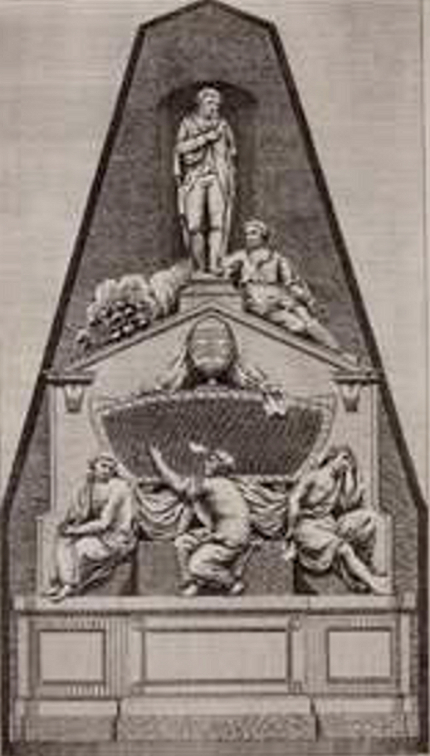Journal Volume 7 2013
Delgany church (continued/1)
The interior of this very pleasing structure is rendered even more interesting by a splendid monument to the memory of David La Touche, Esq. an early member of this distinguished family; it is entirely of white marble, and was executed by Noah Hickey, an Irish artist; the situation of this very fine piece of sculpture is considered by some pharisaical persons as improper, viz. in the eastern end of the church, where the high altar should stand; the same objection was urged against the situation of Lord Corke’s monument, in Saint Patrick’s Cathedral, Dublin, and the monument was ultimately removed by his excellency, Lord Strafford. The La Touche monument stands exactly opposite the western entrance, and from its great height, 24 feet, is a very striking and, affecting object; on the entablature are placed three medallions, one of the Right Honourable David La Touche, on the right Peter, and on the left John; and on one side stands a figure of Mrs. Peter La Touche, holding a cornucopia. The lamented character to whose memory this splendid monument is raised, is represented in large life, standing on a pedestal, which is placed in a niche on the apex of the pediment.

La Touche Monument in Delgany Church
On a broad tablet beneath is this inscription:
Sacred to the Memory of
David La Touche.
On the front of the Urn is inscribed,
Born December, M.DCC.IV.
Died M.DCC.LXXXV.
And on the sides is the following epitaph:
He added unfeigned integrity of principle
To a mild and benevolent nature,
And the most engaging gentleness of
Manners;
But the purity of his mind
Was most strongly evinced
In his constant and unaffected piety.
His life,
Though long and prosperous,
Escaped, alas! too transitory.
Riches, in his hand, became a general bIessing:
His profusion was a disinterested liberality
To the deserving:
His luxury,
The relief and protection of the
Poor and defenceless.
The monument is enclosed by railing, outside which the female children, adopted by Mrs. La Touche, sit during service on Sundays; the communion-table stands at the north side of the church, in a semicircular recess, and behind a skreen of clustered columns, supporting pointed arches, the central one of which is twenty feet high. In front of the communion table stands a baptismal font of black marble, presented to the parish of Delgany many years since, by Chatwoth Brabazon, Esq. Above the grand western entrance is Mr. La Touche’s pew, occupying the whole of the gallery at the western end; it is of carved oak, highly polished, and in the pointed style. There is always in the summer season a very full, and what is usually termed a very fashionable congregation at Delgany Church.
At Delgany was once a religious cell, belonging to St. Mogoroc, the brother of St. Canoc, who flourished about the year 492. The situation of this cell was unknown, until the identity of Dergne or Deigne with Delgany was pointed out by the learned Dr. Lanigan, and sadly mistaken by Archdall, who says it was near Sletty, in the Queen’s County. There was a battle fought at this precise place, called Dergne, or Delgne, in the year 1022, in which Ugair, King of Leinster, overthrew Sitricus, the Danish King of Dublin. “This,” says Dr. Lanigan, “is mentioned by Colgan, who cites the Annals of the four Masters; and by Ware.”


